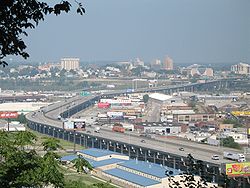This article needs additional citations for verification. (September 2024) |
Lewis and Clark Viaduct | |
|---|---|
 view of the eastbound viaduct in West Bottoms; the since demolished westbound deck truss can be seen in the distance | |
| Coordinates | 39°06′48″N 94°36′54″W / 39.1133°N 94.6149°W |
| Carries | 7 lanes of Kaw River Loop (eastbound lower level) |
| Crosses | Kansas River, West Bottoms, railroad tracks |
| Locale | Kansas City, Kansas–Kansas City, Missouri |
| Maintained by | KDOT and MoDOT |
| Characteristics | |
| Design | various |
| Width | 52 ft (15.8 m) |
| Longest span | 3,777 ft (1,151.1 m) |
| Clearance above | 29 ft (8.8 m) |
| History | |
| Opened | January 29, 1907 (orignal; since converted eastbound) November 12, 1962 (westbound) |
| Statistics | |
| Daily traffic | 23,500 (2008) |
| Toll | Historical, abolished in 1918 |
| Location | |
 | |
The Lewis and Clark Viaduct (previously the Intercity Viaduct and historically the Interstate Viaduct; also known as the 6th Street Viaduct or Woodsweather Bridge) are two nine span viaducts that cross the Kansas River in the United States. Designed by Waddell and Hedrick, the first viaduct, a four-lane, deck truss bridge, opened to the public on January 29, 1907,[1] the second bridge, also of the deck truss design, opened to the public on November 12, 1962.[2] It rises above the West Bottoms, and several sets of railroad tracks. The 1907 viaduct is notable for being the first roadway bridge to connect Kansas City, Missouri, with Kansas City, Kansas, non-stop all the way across. It is about 1.5 miles (2.4 km) long and carries Interstate 70/U.S. Route 24/U.S. Route 40/U.S. Route 169 (I-70/US 24/US 40/US 169). The I-670 Viaduct serves as a complementary to the viaduct, it was built in 1990 to the north.
- ^ "Answers". The Kansas City Star. December 20, 1907. p. 6B. Archived from the original on May 8, 2024. Retrieved December 28, 2021.
- ^ "Intercity bridge spans two states". Kansas City Kansan. March 2, 1986. Archived from the original on August 13, 2007. Retrieved June 23, 2010 – via Kansas City Public Library.